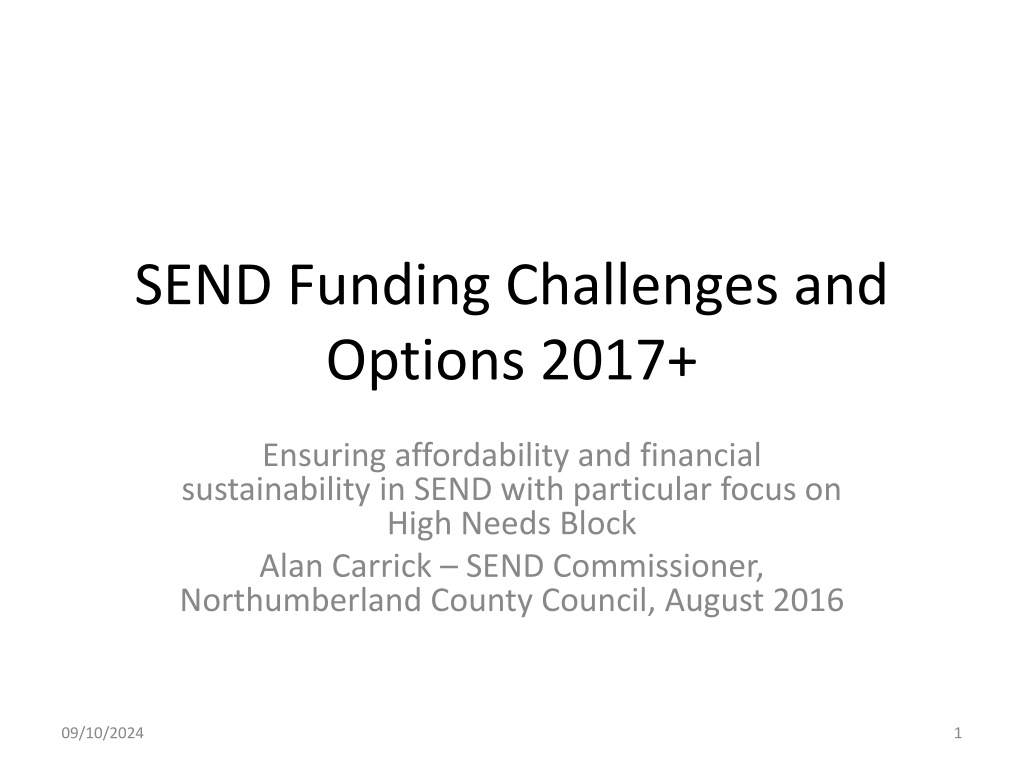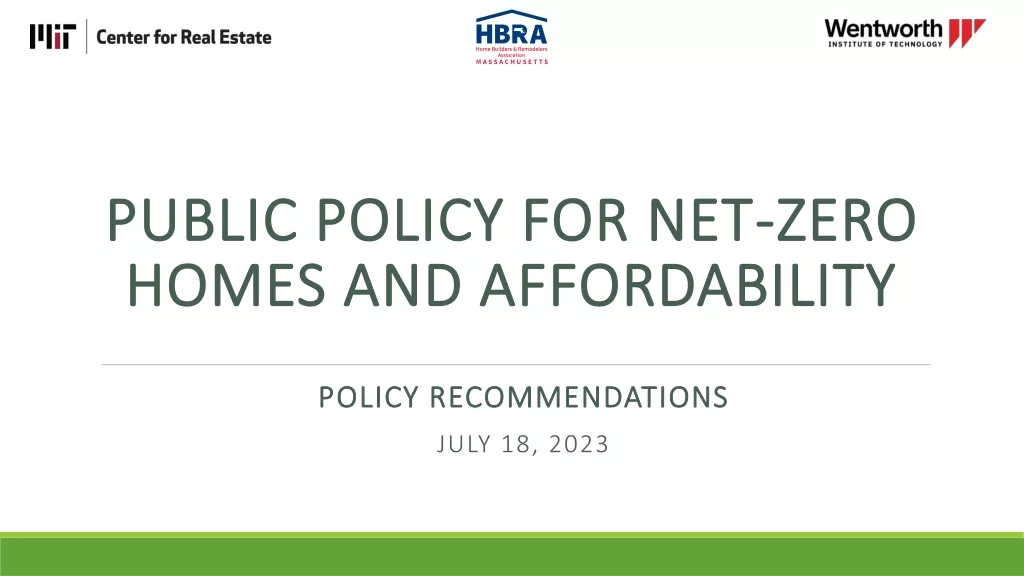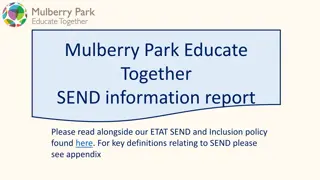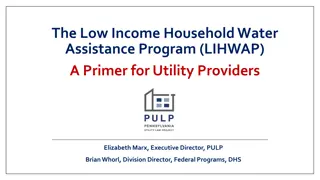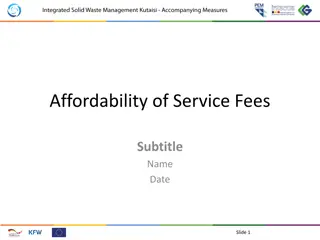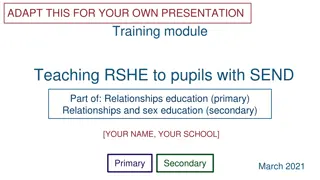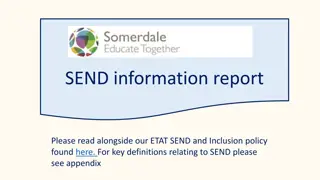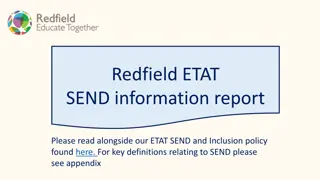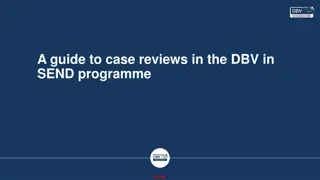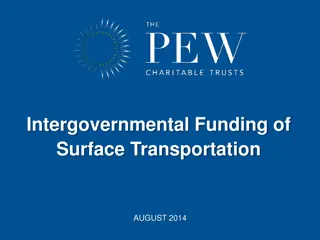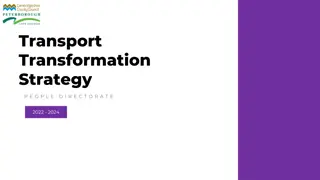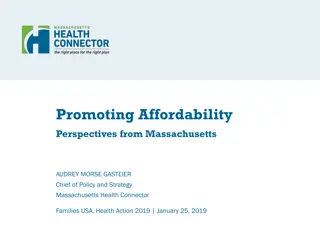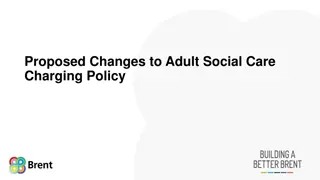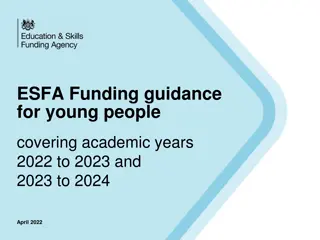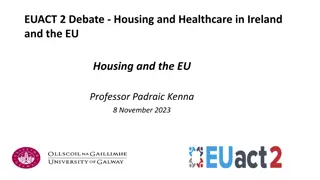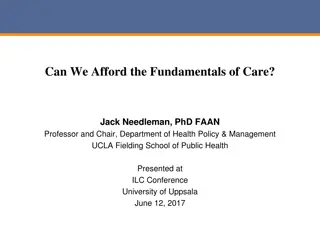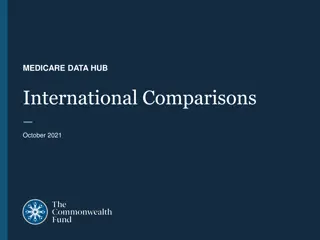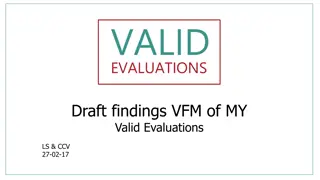Challenges and Options for Ensuring Affordability in SEND Funding
Northumberland County Council faces funding challenges in providing support for Special Educational Needs and Disabilities (SEND) due to lower government funding levels, increased demand for SEN places, and existing financial burdens. The 2014 national SEND reforms have highlighted the need for sustainable funding solutions to maintain the quality and accessibility of SEND services. The review of education funding by the Department for Education is expected to bring about reforms in April 2018, but until then, Northumberland must navigate the financial strains on its SEND provision.
Download Presentation

Please find below an Image/Link to download the presentation.
The content on the website is provided AS IS for your information and personal use only. It may not be sold, licensed, or shared on other websites without obtaining consent from the author. Download presentation by click this link. If you encounter any issues during the download, it is possible that the publisher has removed the file from their server.
E N D
Presentation Transcript
SEND Funding Challenges and Options 2017+ Ensuring affordability and financial sustainability in SEND with particular focus on High Needs Block Alan Carrick SEND Commissioner, Northumberland County Council, August 2016 09/10/2024 1
Northumberlands SEND funding context in 2016 Funding for SEND (and Inclusion) 0-25 years starts here: 16,092,524 from the DSG Schools Block includes 14,917,604 Element 2 SEN Notional Funding into mainstream schools 1,174,920 contribution to SEN Transport total costs of 4,585,000 30,813,610 High Needs Block includes Deductions made by EFA at source for High Needs places Mainstream education Element 3 High Needs top-ups (all sectors and ages) Specialist education (all sectors and ages) Independent Special School places (E1, 2 and 3) Pupil Referral Unit Specialist SEND services (incl. Educational Psychology, ASD, Behaviour, Sensory, Portage, Speech & Lang) Other services for learners with additional needs (incl. LAC, Inclusion Support, Education Welfare, EOTAS) Portable equipment to meet physical disability needs in schools Barndale House School residential provision 2,666,000 4,800,000 10,880,000 3,278,090 400,400 3,764,260 3,540,910 55,000 296,250 Other costs (including therapies, mediation, alternative provision and operational charges) 1,132,700 09/10/2024 2
Northumberland County Councils contribution to SEND The local authority also pays for a range of statutory SEND provision including: SEN Transport costs above the initial DSG contribution, 3,410,080 SEN Team (to manage SEN funding, EHC Plans / SEN Statements, statutory duties etc.) 573,610. Includes grant from DfE of 228,510. It is not yet known if this grant will be available in 2017-2018. Information Advice Support Service (IASS, formerly Parent Partnership ), 50,340 Proportion of Careers Advice and Guidance for learners at risk of NEET, 545,230 Educational Psychology involvement in statutory assessments for EHC Plans, 323,810 Management of SEND legal / statutory / strategic responsibilities 09/10/2024 3
Northumberlands SEND funding context in 2016 The Department for Education conducted a comprehensive review of education funding, including SEND funding. Local authorities hoped to hear how SEND would be more fairly and sustainable funded in future. All Local Authorities in England expected to hear the outcomes of that review by Sept 2016 and be able to plan for the implications from April 2017 onwards. DfE have announced they will carry out further consultation with a view to reforms starting in April 2018 instead. Until then, funding levels are to remain the same. Unfortunately for Northumberland, this does not help us resolve problems that have accumulated over the last 10 years or more: Overall, Northumberland receives lower levels of annual funding from the government than most LAs Local and nationally the number of children with high and / or complex levels of SEN has increased year-on-year The number of available places in local special schools is being exceeded by demand (especially autism, social emotional mental health needs and complex needs from birth). The national SEND reforms of 2014 extended local authority duties by age (raising education obligations from 18 years up to 25 years) and by theme (bringing in those with mental health needs for the first time). This adds many more learners to be provided for with no increase in available funding. In combination, these and other issues create pressures on available resources. In 2015-2016 this led to an overspend against the High Needs Block budget and is likely to do so in the coming years, unless changes are made to our local funding arrangements. The 2015-2016 overspend was mitigated by use of reserve funding. 09/10/2024 4
Northumberland High Needs Block If national funding for Northumberland remains the same year on year, but demand for resources does not decrease there will be an annual accumulation of overspend: In this model an annual overspend of 750,000 has been used, as it reflects the recent experience in 2015 and 2016. Financial year end 2016 2017 2018 2019 2020 Overspend 750,000 750,000 750,000 750,000 750,000 Accumulation 750,000 1.5 million 2.25 million 3 million 3.75 million We have not made projections from 2020 onwards: at that point it is expected a new national formula will address this instead. Given the annual increase in the number of High Needs learners and the fact fewer will exit the system over the next 10-15 years, it may be some years before this pattern plateaus where new learners entering and those exiting are roughly the same each year. Until then, an annual increase in pressure is expected. This financial situation can be resolved. A number of options have been considered. 09/10/2024 5
Proposed solution Move some centrally funded SEND services out of High Needs Block and into Service Level Agreements with schools / colleges. Many local authorities have already done so. Funding from the High Needs Block is released to ensure there is no annual overspend and therefore no accumulation. It would also release some financial space in the High Needs Block to fund growing special schools and top-ups for mainstream High Needs learners. The current government intends all or most schools to become academies in the next few years. They may also propose the ending of Schools Forum. These factors in combination would make central funding of SEND services very difficult and de-delegation across all schools impossible. SLA-based service provision may become the only model for all but a few areas of work. How would this work in Northumberland? At present 7 SEND services are funded for 3.74 million per year from High Needs Block. See slide 2. In many local authorities some SEND services are traded via SLAs with schools / colleges. Typically dyslexia, autism, educational psychology and behaviour support services. In Northumberland that would move around 2.3 million of costs out of High Needs Block annually. 09/10/2024 6
Proposed solution and other solutions considered SLAs would have to be as long-term as possible to allow for staffing recruitment, development and retention say three years. Services which were in demand may increase in size. Others may reduce or change to meet the different patterns of needs. National benchmarking indicates Northumberland schools pay 69 per head for SEN support services but the national averages are 34 and 37 per head. Moving to SLAs would bring us in line with national comparators. Alternative solutions: Standard annual charge to all schools based on size of school / budget 2.3 million represents only 1.3% of the 173,454,868 in mainstream school budgets as a whole. A standard annual charge of 1.3% of each school budget was considered but not considered to be a workable model. 2.3 million is equivalent to 15% of the total amount allocated to school via Element 2 Notional SEND: 14,917,604 in 2016-2017. A standard annual charge of 15% of each E2 school budget was considered but not considered to be a workable model. 09/10/2024 7
Other solutions considered Alternative solutions: Reduce the average level of funding allocated across the system The main tool for this is Element 3 High Needs top ups into mainstream and specialist schools. At present, Northumberland pays 4.8 million to mainstream settings (all age groups) and 4.95 million to maintained specialist schools for E3 top-ups. In total, this is 9.75 million. To change this by 2.3 million would require schools receiving more than 20% less in top ups. Even a modest reduction would be too challenging for many mainstream schools and very challenging for specialist schools (where every learner would be affected). For these reasons this is not considered a viable option. National benchmarking suggest Northumberland is already at the lower end for per-learner E3 top-up funding: Maintained schools 107 average against 123 - 130 nationally Academies 31 average against 38 - 47 nationally Independent / non-maintained 56 against 70 - 75 nationally 09/10/2024 8
Other solutions considered Alternative solutions: Stop doing some of the things in the High Needs Block, or arrange for them to funded from another source There are a two main themes to consider: 1. Cease services which schools do not wish to buy through SLA Schools and academies maintain a larger number of learners in mainstream schools within existing resources 2. Create more affordable local provision so fewer learners attend more costly out of area provision Actions such as these could incrementally create cost benefits in the 100,000s initially. It may take a number of years to reach higher levels of savings needed to both address the immediate overspend and create space for areas of growth. 09/10/2024 9
Conclusion My recommendations are as follows: 1. To reverse the position year-on-year from funding deficit into affordability and room for growth, there needs to be pressure- release of around 1-2 million per year from High Needs Block. 2. The greatest long-term impact can be gained from moving some SEND services into SLA, to be funded by individual school budgets. This may become non-negotiable soon if national funding reforms and academisation are implemented widely in the next few years. 3. Efficiencies should also be sought where possible, reviewing some aspects of existing provision and reducing / changing elements. 4. New specialist provision capacity will need to be created and funded. This should be planned and costed in 2016 ready for financial decisions from 2017 onwards. 5. High Needs top-ups, policy should be reviewed and updated to align with current needs and in readiness for national changes. 6. Schools and families will need to be consulted on changes to our offer in 2016-2017, to ensure we have a strategy and provision and policies that will be well-supported and create positive outcomes for SEND learners. 7. These changes will be implemented in stages at key points including April 2017, Sept 2017, April 2018 and Sept 2018. This timescale will take into account local developments, national reforms and the need for lead-in time for staffing or building changes. In combination, these changes can provide a sustainable and effective level of resource. 09/10/2024 10
